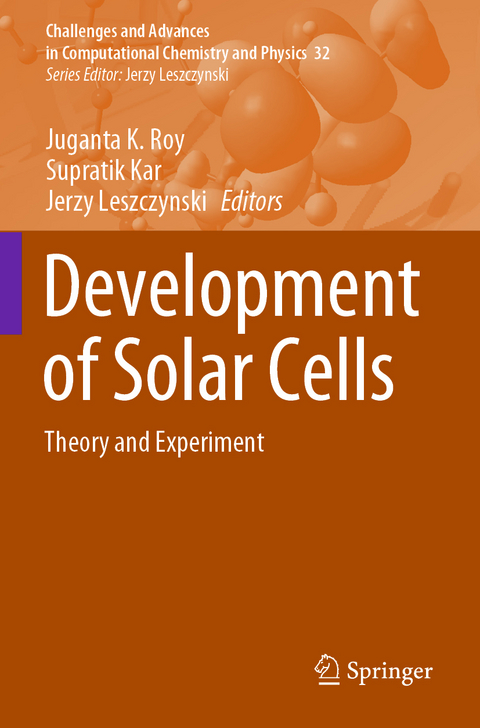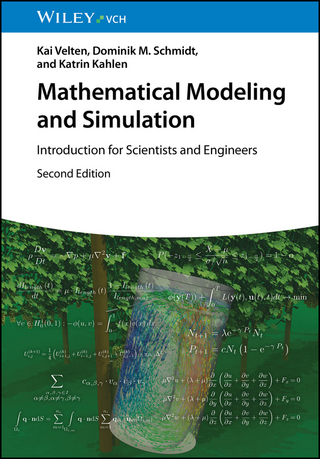
Development of Solar Cells
Springer International Publishing (Verlag)
978-3-030-69447-0 (ISBN)
lt;b>Dr. Juganta K. Roy is a Postdoctoral Research Associate at Jackson State University (JSU), Mississippi, USA. He received his Ph.D. in Chemistry from JSU, Mississippi, USA, in 2018. Dr. Roy completed his M.S. and B.Sc. studies in Applied Chemistry & Chemical Technology from the University of Dhaka, Bangladesh, in 2008 and 2006, respectively. Since 2012 he has been working as an Assistant Professor in the Department of Applied Chemistry & Chemical Engineering, Noakhali Science & Technology University, Bangladesh. His research primarily focuses on the design of optoelectronic materials with the use of different in-silico approaches like QSAR analysis, molecular dynamics simulation of polymeric materials, and electronic structure calculations. Dr. Supratik Kar is a Postdoctoral Research Associate in JSU, Mississippi, USA. He completed his B.Pharm. (2008) and M.Pharm. (2010) degree in Jadavpur University (JU), India, securing the first position in both degrees. He earned his Ph.D. (2015) from JU, India. He is a former Visiting Researcher from the University of Gdansk, Poland, under the Marie Curie research fellowship. He has over ten years' experience in QSAR, machine learning, and chemometric modeling studies in the field of drug design, toxicity prediction, and physicochemical property modeling. To this date, he has published over 70 research and review articles, 18 book chapters, and 2 QSAR textbooks. He is acting as a Reviewer for 50 peer-reviewed journals and has performed over 230 reviews. Prof. Jerzy Leszczynski is Professor of Chemistry and President's Distinguished Fellow at JSU, Mississippi, USA. His research activities include studies of the nature of chemical bonds, theoretical predictions of molecular potential energy surfaces, structures of weakly bonded complexes, properties of DNA fragments, interactions of explosives with soil, properties, and toxicity of nanomaterials. He has published more than 1000 refereed papers in leading journals and more than 80 book chapters. He has edited and co-edited more than 50 books and has advised 31 students who already received their Ph.D. degrees. He has been cited almost 34,000 times and carries an H-index of 88 (Google Scholar). Among his international awards are: a Guest Professorship, Chinese Academy of Sciences, Shanghai, China 2002; an Honorary Doctorates, Dnipropetrovsk National University, Ukraine 2003, and Wroclaw University of Technology, Poland 2013, Award of the Academic Council of the Taras Shevchenko National University (TSNU) of Kyiv, the most distinguished TSNU recognition, Ukraine 2013, the Maria Sklodowska Curie's Medal (Medal for prominent chemists working permanently abroad) Polish Chemical Society, Poland 2007, Honorary Doctorates, Wroclaw University of Technology, Poland 2016. He has been shortlisted for European Academy of Sciences 2002; International Academy of Engineering, 2003; Ukrainian Ecological Academy of Sciences, 2003; and European Academy of Sciences, Arts and Humanities, 2004. He received White House Award in 2001 and the USA Presidential Award in 2009.
Recent Progress in Perovskite Solar Cell: Fabrication, Efficiency, and Stability.- State-of-the-Art of Solution-Processed Crystalline Silicon/Organic Heterojunction Solar Cells: Challenges and Future.- Structure, Electronic and Charge Transfer Properties of Organic Photovoltaics from Density Functional Theory Methods.- Dye-Sensitized Solar Cells: A Brief Historical Perspective and Uses in Multijunction Devices.- Delving Charge-Transfer Excitations in Hybrid Organic-Inorganic Heterojunction of Dye-Sensitized Solar Cell: Assessment of Excitonic Optical Properties Using the GW and Bethe-Salpeter Green's Function Formalisms.- Promising DSSCs involving organic D-pi-A and similar structures for n- and p- type semiconductors - A Theoretical Approach.- Application of QSPR Modeling in Designing and Prediction of Power- Conversion Efficient Solar Cell.- Computational Screening of Organic Dye-sensitizers for Dye-sensitized Solar Cells: DFT/TDFT Approach.- Chemometric modeling of absorption maxima of carbazole dyes used in dye-sensitized solar cells.
| Erscheinungsdatum | 14.05.2022 |
|---|---|
| Reihe/Serie | Challenges and Advances in Computational Chemistry and Physics |
| Zusatzinfo | XVI, 235 p. 106 illus., 99 illus. in color. |
| Verlagsort | Cham |
| Sprache | englisch |
| Maße | 155 x 235 mm |
| Gewicht | 391 g |
| Themenwelt | Naturwissenschaften ► Chemie |
| Schlagworte | dye-sensitized solar cell • hybrid solar cell • Inorganic solar cell • Organic Solar Cell • Perovskite solar cell • photo-chemical • Polymer Solar Cell • Quantum and Computational Chemistry • Simulation • Solar cell |
| ISBN-10 | 3-030-69447-X / 303069447X |
| ISBN-13 | 978-3-030-69447-0 / 9783030694470 |
| Zustand | Neuware |
| Informationen gemäß Produktsicherheitsverordnung (GPSR) | |
| Haben Sie eine Frage zum Produkt? |
aus dem Bereich


